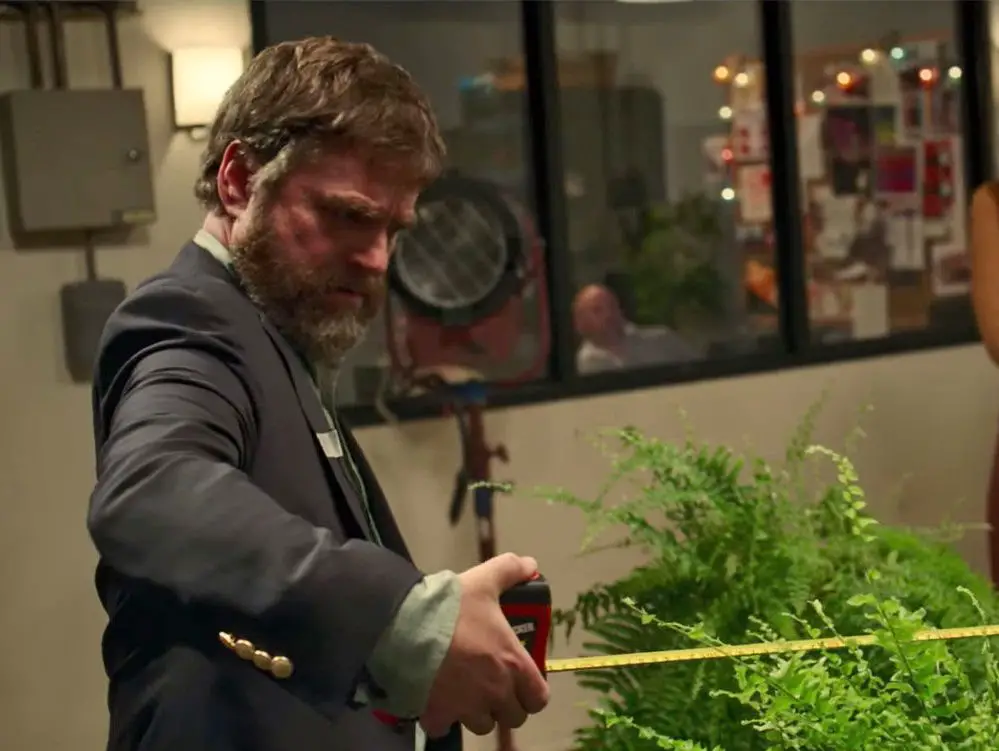From Johnny Carson and Dick Cavett to Jimmy Fallon and Stephen Colbert, late-night talk show hosts have always acted as accessories to the entertainment industry and politics, bridging the communication gap between celebrities and fans. The talk show/interview format dispels the illusion of a celebrity’s status and gets at the heart of who they are as people, in a way that only a face-to-face conversation can accomplish. “Between Two Ferns: The Movie,” however, breaks the conventions of etiquette associated with normal conversations and pursues the worst possible outcomes of human interaction.
Beginning as a comedy skit for the online comedy website and production company “Funny or Die,” “Between Two Ferns” is a talk show, taking place in the middle of two ferns, where its host, Zach Galifianakis, asks well-known names in entertainment and politics rather awkward and inappropriate questions a sensible interviewer would otherwise avoid. Galifianakis plays a rude, sardonic version of himself using improvisation, while his guests, despite being in on the joke, try to not to take the comedian too seriously as he continuously insults their career and appearance.
“Between Two Ferns” as a short comedy skit is an effective way of showcasing its concept to the fullest extent. In contrast, “Between Two Ferns: The Movie” does not display its premise to the same degree, due to the inclusion of a narrative and character progression that distracts from the original’s socially improper nature. Apart from the film’s lack of the same potency seen in skit form, the movie’s mere 83-minute runtime, and Galifianakis’ portrayal of an offensive version of himself, still makes it a manageable film to watch.
Instead of reiterating what other reviewers are saying about the film’s flaws, here is what “Between Two Ferns: The Movie,” as well as its precursor, accomplishes and how it speaks to current culture and society.
Solidifying the Importance of Formality and Politeness
“Between Two Ferns” is an outlet for viewers to laugh at Galifianakis’ immaturity and lack of common sense while receiving some level of relief knowing that their behavior is not as bad as his. The audience recognizing that Galifianakis’ actions of humiliating and undervaluing his guests are wrong stems from their knowledge of the socially acceptable way of treating others. For viewers to consider Galifianakis’ conduct reprehensible and therefore make fun of him, a set of rules are needed that detail the acceptable manner in which people should converse. By breaking these rules of decorum, “Between Two Ferns” entertains the idea of what human interaction would be like if no rules existed in the first place.
Demonstrating the necessity of propriety, the film affirms the reasons why behavioral guidelines are put in place, where without them, people would have no reason not to act like Galifianakis. In a time where a single disagreement with someone can provoke resentment, the film does well to remind people that civility and kindness are vital attributes to have when speaking with others and that bearing hostility toward another person will only make matters worse.
Critique of Celebrity Status
“Between Two Ferns,” at its most basic level, makes fun of show business and people’s often extreme obsession with the lives of celebrities. Social media has enabled people’s desire to know everything about their favorite actor/actress or public figure, which has left some people susceptible to putting famous people up on a pedestal. It is this manufactured, elevated status that people have placed on celebrities that the film (itself composed of celebrities) mocks, an irony that all the more adds to its hilarity.
In an interview with “theoffcamerashow” on YouTube, Galifianakis discusses how he prefers being a comedian rather than an actor, saying how he hates the word “celebrity” and instead sees himself as, “just a dumb actor that just wants to do his little part and not have to talk about it much.” Unlike some actors who may only act for the money or fame, he is comfortable not having the status other personalities possess, enjoying acting simply for the sake of acting and its effect on the audience.
Another aspect of celebrities “Between Two Ferns” derides is their often attractive physical appearances, which Galifianakis is known to mention, notably in his interviews with Jon Hamm, Bradley Cooper and Brad Pitt, as the only reason why they’re allowed to act. His comment is usually met with a blank stare or a raised eyebrow, but it still makes one wonder if the actors ever reflect on that question as if it were serious and not made in jest. Regardless of whether questions posed by Galifianakis are in bad taste or not, some are still worthy of contemplation and shouldn’t be easily discarded with awkward silence.
The Benefit of Self-Deprecating Humor
Continuing with celebrity looks, Galifianakis himself has said that he knows he’s not the most attractive person in the world and is prone to making several jokes about his appearance. With his aversion towards celebrity as a term, he doesn’t subscribe to the superficial notion that sex appeal is the only requirement for fame, nor does he consider his appearance a complete detriment to his career. Not falling for any potential body-shaming, Galifianakis goes against the fan-generated status quo of a celebrity’s perfection, revealing the reality of celebrities not being different from ordinary people and that they are under the same pressures of trying to be what’s expected of them.
In “Between Two Ferns,” Galifianakis employs his self-deprecating humor to depict a person who isn’t aware of his indecency, calling out people who also never think of taking the blame and always feel that they’re in the right. While degrading yourself for the amusement of others can lead to self-esteem issues, it is sometimes necessary to stay humble and not make yourself out to be above a particular problem. Coming to terms with embarrassment and failure fosters room for personal growth and will lead to the betterment of yourself after having learned from them. To not see any faults in yourself and to live a life with arrogance will make you no better than a celebrity placed on a pedestal.
Don’t Be Like the “Between Two Ferns” Version of Zach Galifianakis
The concept from which “Between Two Ferns: The Movie” arose does more than just provoke a few chuckles. Instead, it stresses the need for respect, pierces through the facade of a perfect, unrelatable life of a celebrity and promotes humility as a virtue. When you watch episodes of “Between Two Ferns” and find yourself laughing at Galifianakis, ensure that you aren’t laughing with him.
















